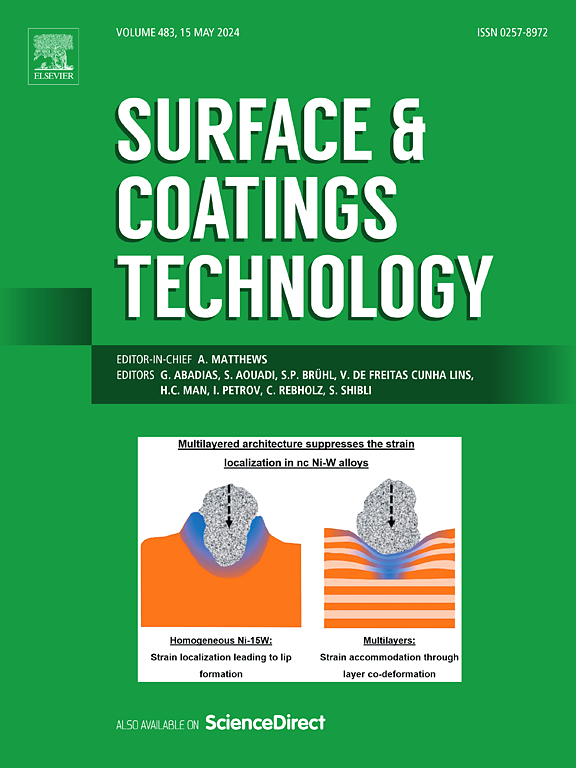Enhancement of wear resistance in AZ31 alloy by laser melt injection of high-volume-fraction titanium carbide particles
IF 5.3
2区 材料科学
Q1 MATERIALS SCIENCE, COATINGS & FILMS
引用次数: 0
Abstract
In this study, defect-free and crack-free TiCp/AZ31 composite coatings with a high TiC volume fraction (30–40 vol%) were successfully fabricated. The influence of the high ceramic volume fraction on the properties of these coatings was systematically investigated. The results reveal that a laser energy density of 40–60 W/mm2 induces minimal dissolution of TiC particles in the molten pool, ensuring essential metallurgical reactions between the magnesium matrix and TiC. This process facilitates the formation of a semi-coherent interface between Mg and TiC while effectively suppressing the generation of defects such as porosity and cracks in the molten pool. As the TiC volume fraction increases, the microhardness of the TiCp/AZ31 composite reaches 485 HV, representing a remarkable 766 % enhancement compared to the AZ31 matrix. Concurrently, the wear rate decreases by up to 74 % relative to the AZ31 matrix. The incorporation of TiC shifts the dominant wear mechanism of the magnesium matrix composite from adhesive wear to mild abrasive wear. The significant improvement in the wear resistance of the TiCp/AZ31 composite coatings holds promise for providing a novel solution for the application of magnesium alloys in lightweight, wear-resistant composite materials.
激光熔融注射高体积分数碳化钛颗粒增强AZ31合金耐磨性
在本研究中,成功制备了具有高TiC体积分数(30-40 vol%)的TiCp/AZ31无缺陷和无裂纹复合涂层。系统地研究了高陶瓷体积分数对镀层性能的影响。结果表明,激光能量密度为40-60 W/mm2时,熔池中TiC颗粒的溶解最小,保证了镁基体与TiC之间的基本冶金反应。这一过程有利于Mg和TiC之间形成半相干界面,同时有效地抑制了熔池中气孔和裂纹等缺陷的产生。随着TiC体积分数的增加,TiCp/AZ31复合材料的显微硬度达到485 HV,比AZ31基体提高了766%。同时,与AZ31基体相比,磨损率降低了74%。TiC的加入使镁基复合材料的主要磨损机制从黏着磨损转变为轻度磨粒磨损。TiCp/AZ31复合涂层的耐磨性显著提高,有望为镁合金在轻质耐磨复合材料中的应用提供一种新的解决方案。
本文章由计算机程序翻译,如有差异,请以英文原文为准。
求助全文
约1分钟内获得全文
求助全文
来源期刊

Surface & Coatings Technology
工程技术-材料科学:膜
CiteScore
10.00
自引率
11.10%
发文量
921
审稿时长
19 days
期刊介绍:
Surface and Coatings Technology is an international archival journal publishing scientific papers on significant developments in surface and interface engineering to modify and improve the surface properties of materials for protection in demanding contact conditions or aggressive environments, or for enhanced functional performance. Contributions range from original scientific articles concerned with fundamental and applied aspects of research or direct applications of metallic, inorganic, organic and composite coatings, to invited reviews of current technology in specific areas. Papers submitted to this journal are expected to be in line with the following aspects in processes, and properties/performance:
A. Processes: Physical and chemical vapour deposition techniques, thermal and plasma spraying, surface modification by directed energy techniques such as ion, electron and laser beams, thermo-chemical treatment, wet chemical and electrochemical processes such as plating, sol-gel coating, anodization, plasma electrolytic oxidation, etc., but excluding painting.
B. Properties/performance: friction performance, wear resistance (e.g., abrasion, erosion, fretting, etc), corrosion and oxidation resistance, thermal protection, diffusion resistance, hydrophilicity/hydrophobicity, and properties relevant to smart materials behaviour and enhanced multifunctional performance for environmental, energy and medical applications, but excluding device aspects.
 求助内容:
求助内容: 应助结果提醒方式:
应助结果提醒方式:


